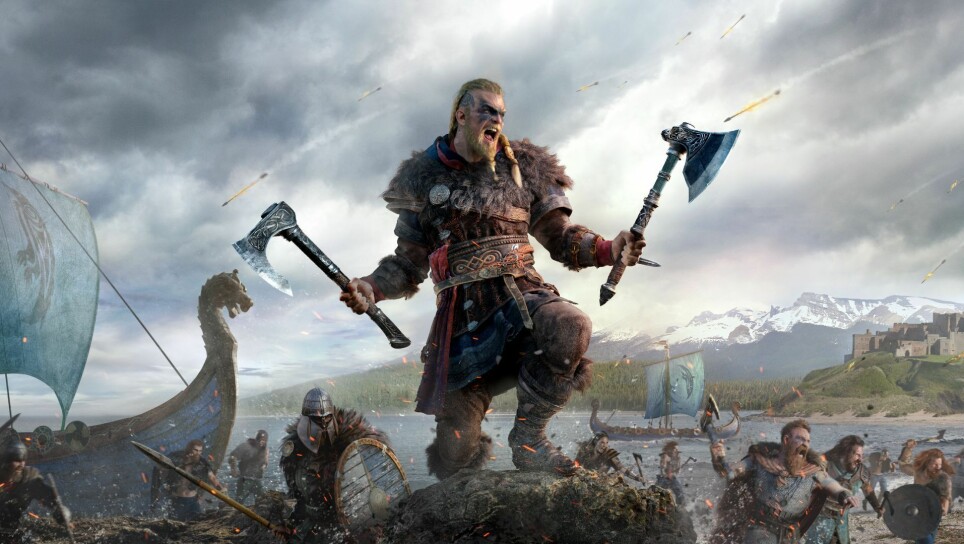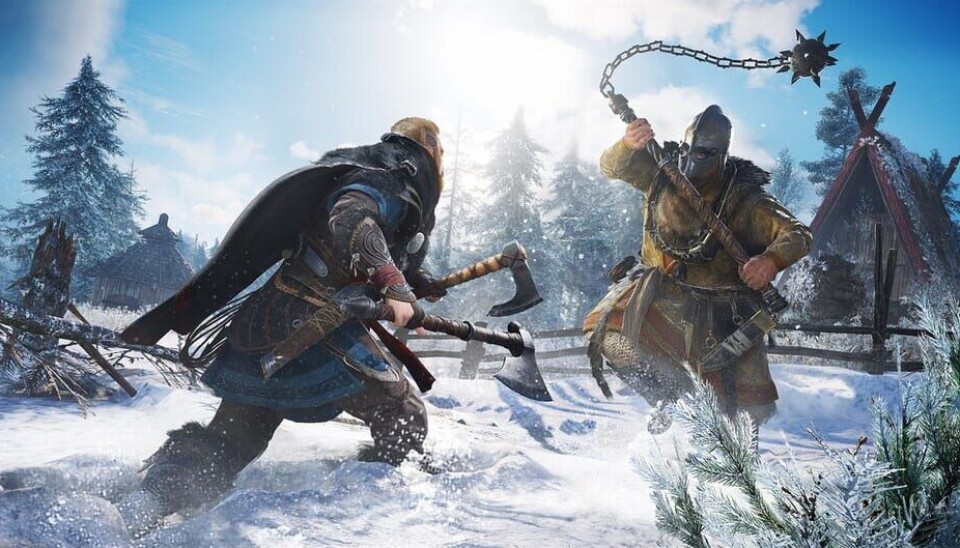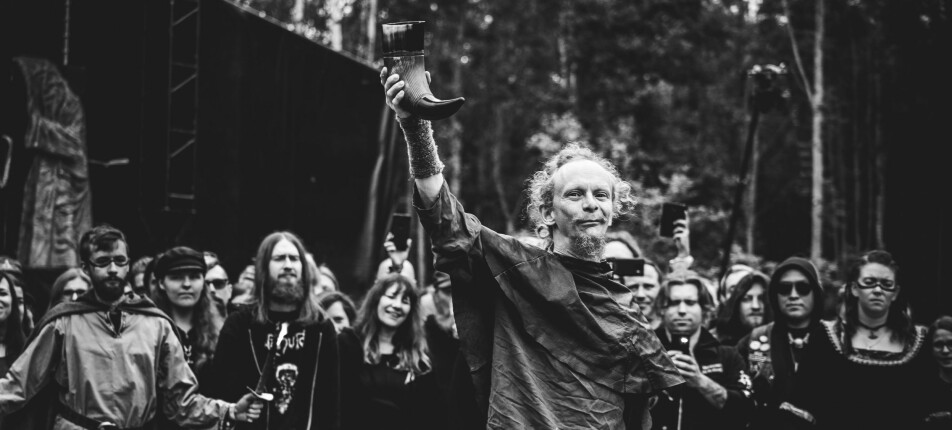
The Viking version of Assassin’s Creed is surprisingly violent, according to researcher
The game is part of an explosion of popular culture created around a contemporary idea of Vikings and Norse mythology, where violence often plays a large part.
There is a level of brutality present in Assassin’s Creed: Valhalla which is not typical for this blockbuster game series, according to Jane Skjoldli.
She is one of five researchers in the project Back to blood at the University of Stavanger. Over the next few years Skjoldli and her colleagues will analyze how the contemporary idea of Vikings is constructed, interpreted and promoted in various cultural spheres. Skjoldli’s project focuses on popular culture in the lives of those who are interested in all things Viking.
As part of her study of music, movies and digital games, Skjoldli has been studying Assassin’s Creed Valhalla, which was released in November 2020.
She finds the game represents a specific type of popular culture Viking – a brutal warrior, who simultaneously embodies somewhat progressive gender norms while also representing a conservative masculine ideal.
Compared to the other Assassin’s Creed games however, Skjoldli has observed a difference in the quality and level of violence she has observed in the game.
The researcher stresses that she herself is a gamer.
“I’ve been a gamer for as long as I can remember,” Skjoldli asserts.
“When violence in games is being discussed in the public debate, I am usually not the one to react and participate. However, I quite understand those who have reacted to the level of brutality in Valhalla,” she says.
Some gamers have discussed the issue on social media, complaining that the finishing kill animations on people and animals are unnecessarily long and repetitive.

Forced to watch the kill
An important part of the game is to rob monasteries. A large chunk of the game takes place in a fledgeling Viking colony in England, which the player has to build with pillaged materials.
When there is a fight between the player and a computer-controlled figure, the goal obviously is for the player to win – meaning killing the other. So far, this is normal.
“However, when this happens in Valhalla, it seems that nearly every single time, the camera and the player is overtaken by the game mechanics – you lose control over your avatar, or character, and are forced to watch a sequence in which an unusually long and obnoxious killing sequence takes place,” Skjoldli explains.
“It becomes a sort of repetitive forced sequence of violence, where your character disarms the other, takes the weapon and overkills by pounding the enemy ad nauseam. It’s a sequence that takes about 5-6 seconds, and this can feel like a very long time when it is repeated over and over. It seems to encourage sadistic responses to violence,” she says.
Although Assassin’s Creed is a game series where the goal has always been to assassinate people, these killings have not commonly been nearly as brutal or graphic as in the Viking version according to Skjoldli.

Assumption that the player will enjoy beheading wolves?
Some of the more extreme sequences can be toned down by the player. You can regulate the amount of blood shown for instance, and you can choose whether or not you want to follow a camera angle that follows the dagger into the intestines of the person or animal being killed.
“This is more graphic than most other games I have played in this genre,” Skjoldli says.
“What is also quite unusual, even for a game with a high level of brutality, is that this violent killing sequence also plays out when you kill an animal. You are forced into a scene where you perhaps behead a wolf, and you cannot turn it off, you are forced to watch it unless you avoid the sequence altogether by killing it with a bow and arrow. The assumption seems to be that players will enjoy this,” the researcher says.
Perhaps responding to criticism, the company Ubisoft updated the game in late April this year, and now allows players to also turn off the forced watching of the end of the kill.
“Assassin’s Creed Valhalla is full of close-ups on gory, Viking violence”, the website polygon.com wrote. “But after the game’s latest patch, it doesn’t have to be”.

Violence for the sake of violence
Skjoldli at first wondered if the Viking version was perhaps created by a different studio than the other games in the series. But its production was headed by Ubisoft Montreal, the same studio that made Assassin’s Creed Origins and with many of the same people at the helm.
“That game was praised for the level of dialogue the developers had with researchers,” according to Skjoldli.
The developers used their newfound knowledge of ancient Egypt in order to create a game which attempted to reach a high level of historical accuracy.
Assassin’s Creed Valhalla on the other hand, has been described as Viking Fantasy, even though dialogue with researchers has had an impact on the game in some respects, according to Skjoldli
“The game doesn’t give you a made-up story set against an approximately historically accurate background, rather it draws you into a Norse mythological universe mixed with historical fiction,” Skjoldli says.
“The game throws you straight into one of the Norse creation myths, and then places you somewhere on the west coast of Norway where northern lights shine forever and there are stave church-like buildings everywhere. Historically it’s a complete mix of elements that belong far later in history as well as mythology and pure fiction but presented in a game series that players are used to engaging as more closely linked to research,” she says.
The developers have been inspired by the tv-series Vikings, according to Skjoldli – something which can be witnessed for instance in the game characters’ hairstyles, music, and perhaps also the graphic violence.
“It’s hard to find any narratological justification for the invasive and repetitive violence aside from a prevailing conception of Vikings as exceptionally brutal; at times it seems to be violence for the sake of violence,” Skjoldli says.
Even in cases where the player chooses a non-violent or less option at a crossroads in the story, the game overrides player agency, which goes against the game series’ precedence as well as the dominant trend in other games of the genre.
It appears as though the game leans on a popular idea of what the Vikings were like, she believes.

Progressives from the past
The modern idea of the Viking doesn’t just circle around violence, however. There is also a sanitization of their morals, according to Skjoldli.
“Both when it comes to gender roles and interaction with people from other parts of the world, it seems Vikings are portrayed as somewhat better than they perhaps were”, she says.
Viking women are consistently portrayed as strong individuals with access to all of society and with complete freedom to express their gender, according to Skjoldli. Homosexuality appears more accepted than it probably was.
“It’s obvious that people project today’s ideals of equality on these Vikings,” the researcher says.
Historical Vikings were most likely not as progressive as many who engage Vikings as a popular culture product would prefer. Among other things, they kept slaves like many other societies in that period. Owning people as if they were property was legally regulated.
“There is a lot about the actual pre-Christian Norse and wider Nordic society that does not come into play when it is revived in popular culture and spirituality today,” says Skjoldli.
“But that’s probably ok. If what you’re creating is an ideal it’s a good idea to leave the more problematic sides out,” she says.
Later in her project Skjoldli will be studying the reception of Viking-inspired popular culture products among people who identify with Asatru and Heathenry more broadly – contemporary interpretations of Norse mythology.
Not worse than the norm at the time
Marianne Moen is an archaeologist at the University of Oslo. Her field of study is Vikings related to gender and social identities.
She says that the Vikings were neither as progressive as modern portrayals would suggest, nor as old fashioned as some of the research from the 20th century would have it.
“A lot of our conversations about this need to be had over again, there are a lot of misconceptions out there,” she says.
That Vikings were particularly violent is something Moen spends a lot of time talking about within her own work as well – it’s simply not quite true.
“They weren’t mild and kind, but just how violent were they, and where do our stories come from?”, she asks.
According to Moen, a fair share of our historic knowledge about the Vikings comes from English written sources.
“We have a lot of descriptions of the Vikings written by those who were at the receiving end of this violent expansion,” she explains.
The Vikings were also outliers at the time; the rest of Europe was christened, the Vikings were not. This has also resulted in stories where the Vikings are easily seen as the other and attributed more of that which is not to like, according to Moen.
“At home however, the Vikings were not a very violent people. Society was well regulated by law, there were strict legal rules governing behaviour, and violence was not a natural part of everyday life”, Moen says.
“So the Viking society certainly was not a violent society. I’m not saying they were peaceful tradesmen, but I don’t think they behaved worse than what was the norm at that time.”

It’s ok to like Vikings again
Why are the Vikings all of a sudden so popular then?
“They’re everywhere, right!”, the archaeologist confirms.
Some of this she believes is because it has finally become ok to be into Vikings again.
“After the second world war it wasn’t so ok to like Vikings, as they were so strongly misused by the Nazis. The symbolism came with a bitter aftertaste for a very long time after this. But this is now gone, our collective memory isn’t necessarily so long. And it’s a story that is easy to like,” Moen says.
Vikings have been popular throughout history, it’s a compelling story, according to Moen. And when something becomes so popular, you’re bound to get simplified versions of what things were really like.
“A lot of people feel a sort of ownership to the Viking Age, in that they feel they know what it was about. But what they know is often a very simplified version. Based on this they believe they know what the Vikings thought and believed, and how they behaved”, she says.
But it’s a shame that Vikings are presented as more violent than they were, or than others, according to the archaeologist.
“It lingers and ends up becoming a narrative that people believe to be true about the past, and then it becomes a self-fulfilling prophesy,” Moen says.
In recent years, right-wing extremists, neo-Nazis and white power groups have taken Vikings to heart, and again the Viking warrior is being used to justify committing atrocious deeds around the world.
Moen believes it’s partly up to researchers like herself to turn the tide.
“A lot of people are interested in Vikings because Vikings are interesting. And we who work as researchers in the field need to take responsibility and convey complex and positive stories, so this part of history is not only used by right-wing extremists.”
































